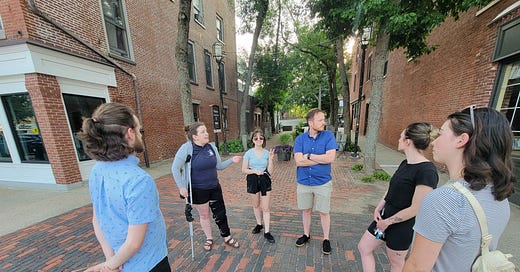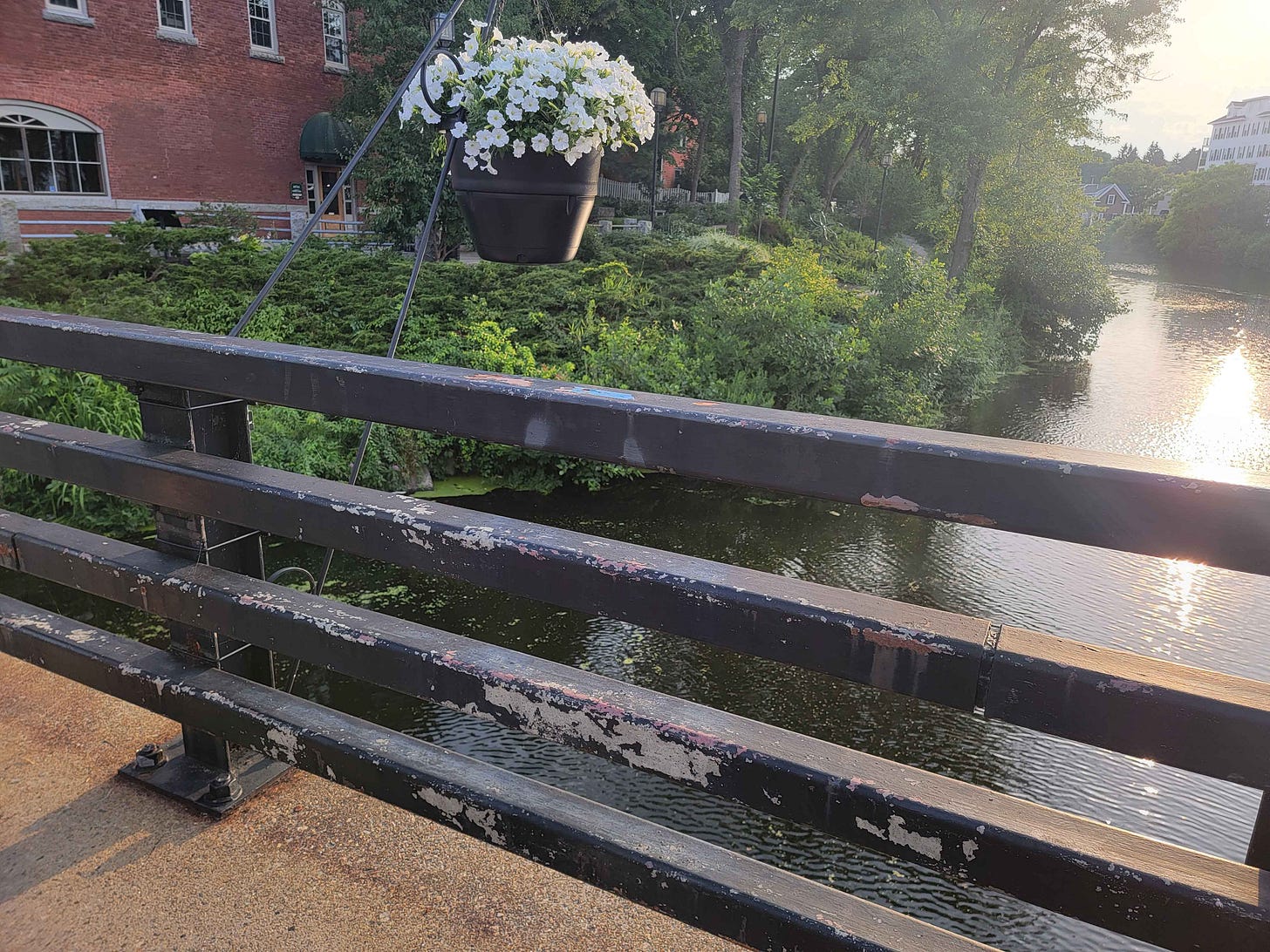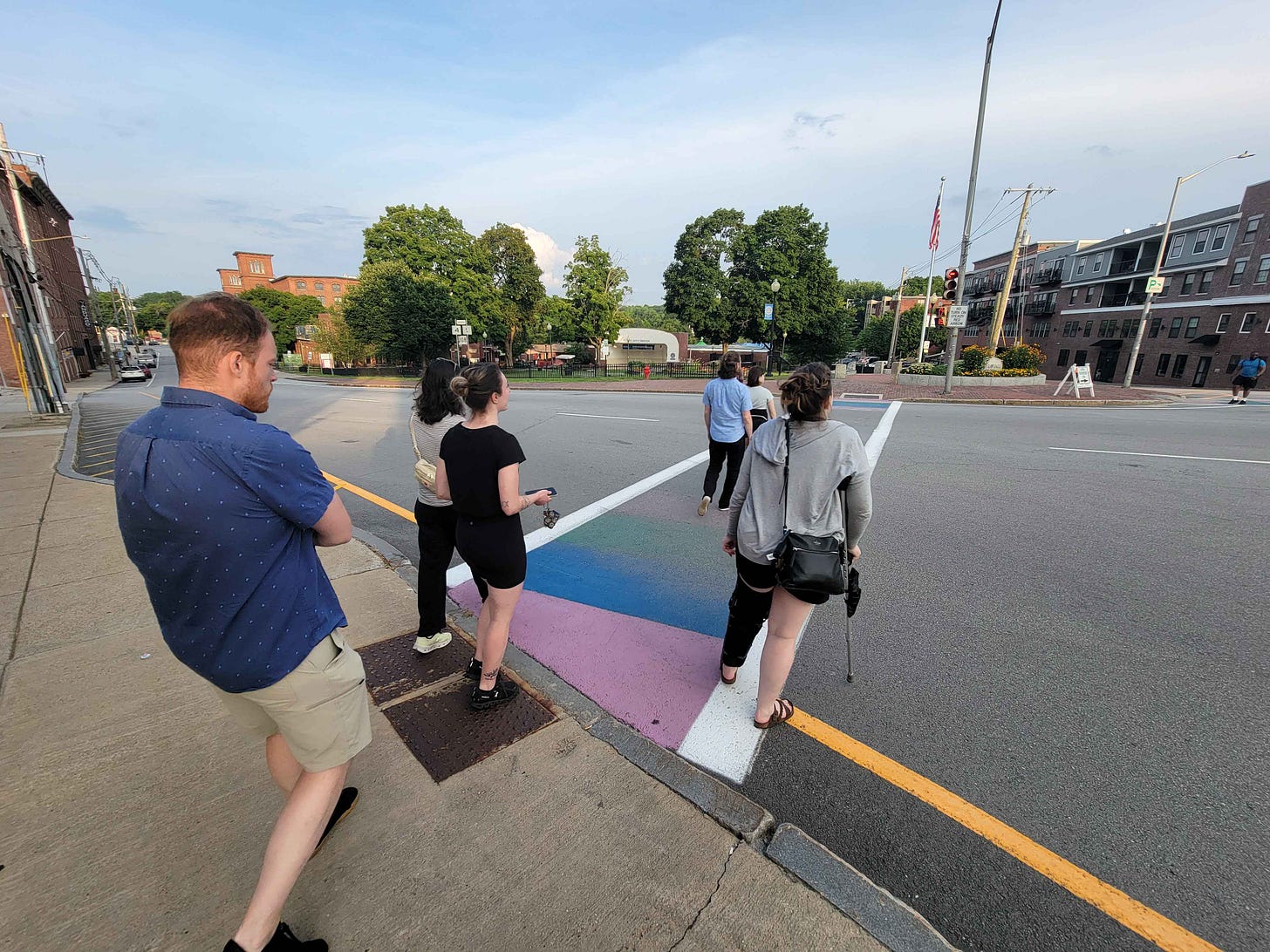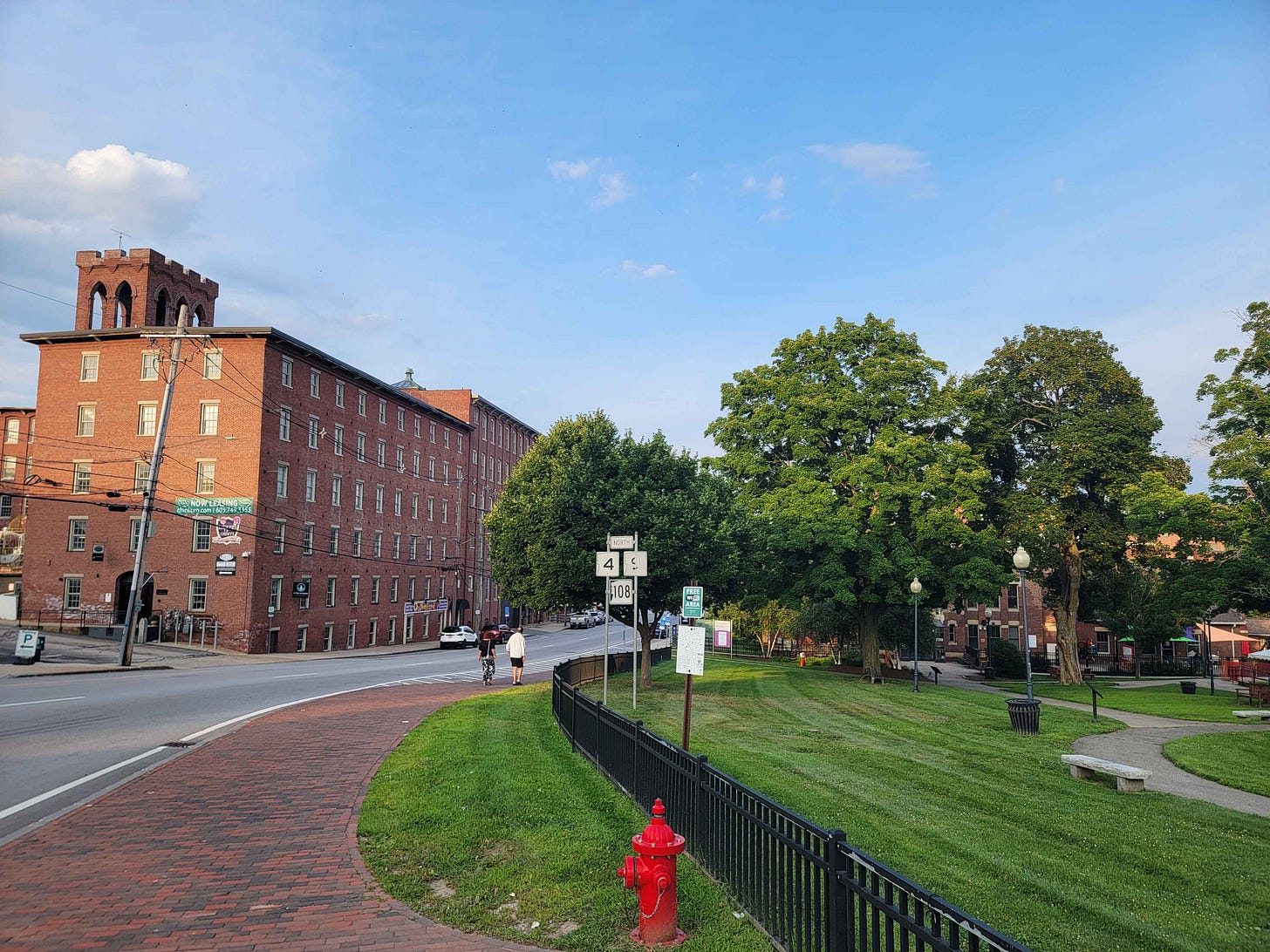A Walking Audit in Downtown Dover
We walked around Dover's downtown and took notes on where improvements could be made and what is working well
Thank you for reading the Strong Towns Seacoast Newsletter. We recently held our first Monday meeting where we conducted a walking audit of downtown Dover to make observations and notes about what to suggest to the city to improve. It was a fun, active meeting and there were a few new faces that showed up and I am grateful for their interest in our group.
August 2024 Meetings
Let’s talk details for this month’s meetings and then we will jump right into the results of our audit.
Monday Meeting Details
Monday, August 26th 6:30PM - 8:00PM
Juniper Kitchen in Dover
We will be watching some videos that discuss Strong Towns principles and help explain what makes a place resilient over time.
Saturday Meeting Details
Saturday, August 17th 10:30AM - 12:00PM
Dover Public Library Learning Center
We will explore several ideas for community projects to do in Dover. These range from painting benches in the park to working to spruce up Waldron’s Court in downtown. Our goal will be to identify a volunteer project that we are capable of handling on our own and take that next, smallest step in making the seacoast better.
Why Conduct a Walking Audit
When I worked for EBSCO Industries on their UI/UX team we would look at improving the experience for people who were using our companies web applications. There were a number of tools that we used to evaluate user feedback and one of them was called “Going to the Gemba” which uses a Japanese word that means “the actual place”. For us, it was a way to get out from behind our computer screens and move past studying analytics, to go to where the problem is directly experienced and observe it from there.
That concept is very similar to what we are trying to accomplish with our walking audit, we want to go to the gemba and find out what it is like to walk there so that we can better recommend changes or solutions to the city.
Highlights from Our Walk
We started at Juniper Kitchen on Third Street and went to Henry Law Park then circled back using Main Street. Along the way we identified and discussed various things that we encountered along our walk and these are some of the ones that stuck out to us the most.
#1 Ugly paint on the bridge
The flaking and damaged paint job on the bridge across the Cocheco River on Central Avenue stands out in contrast to the beautiful flowers that Dover Doers hung up along it this year. This seems like an easy fix, just smooth it out and repaint it, right? Well, I spoke with Deborah Clough from Dover Doers and she informed me that bridge actually has lead paint covering it and while painting over it is an option, it would be rough looking with the damaged coat underneath it. The task of removing the old paint so that it would have a smooth finish would be a large undertaking, especially with the river below it. Even though the task is more challenging than we initially thought, it still stood out to us as an area that the city could address.
#2 Short amount of time to cross Washington to Henry Law Park
When we crossed Washington Street to get to Henry Law Park there was only 20 seconds of dedicated time for us to cross. We did have a member of our group who was wearing a leg brace with a crutch and 20 seconds was just not enough time for her to fully cross the intersection. This crosswalk is right next to the park and there should be an expectation that people exploring either the downtown shops or the park will use this crosswalk to navigate between those places.
This is one of, if not the busiest intersection in downtown, and even though it only has two lanes, they are very wide. The crosswalk from TD Bank to Henry Law Park is 62’ wide which means the lanes are an average of 31’. Do we really need that width for two vehicle lanes in an area with heavy foot traffic? Narrower lanes here would decrease traffic speeds and reduce the distance that people need to walk to safely cross the street. A plan for that would take time, but a faster solution would be to just add some seconds to the crosswalk clock so that people have enough time to cross.
#3 No crosswalk between The Children's Museum and Noggin Factory
While we are talking about crosswalks at Henry Law Park, let’s acknowledge that there are a lot of attractions for families in that area such as The Children’s Museum, The Noggin Factory, and Lickee’s and Chewy’s. Combine those with the park and the splash pad and you have a wonderful family attraction. Unfortunately there are three highways worth of vehicle traffic (highways 4, 9, and 108) that splits those attractions apart from each other and make the connection between those places a challenge for parents to navigate. Walking from the museum to the toy store should be so easy to do, but there isn’t even a crosswalk for people to use.

In fact, the closest crosswalk is the one that we were just talking about with a 20 second timer. According to Google Maps, the sidewalk in front of The Children’s Museum is about 60’ away from The Noggin Factory, but the path to walk there is 530’ because there is no crosswalk here. We think this is a missing opportunity for the city that can provide a lot of relief for parents who want to explore these separated attractions.
#4 Narrow sidewalks across the bridge

The sidewalk along the bridge between The Children’s Museum and Furies Irish Pub was very narrow, around 5’ in width, for it to be near so many attractions. As we were saying above, there are likely parents who walk across this bridge with strollers or toddlers and take up most of the available space. If two families with strollers were to cross paths heading in opposite directions that could be tricky with such a narrow area and a curb. The street here is 44’ wide and we could narrow the vehicle lanes to widen the sidewalk for people walking along this path. Maybe with narrower lanes this would be a good place to put that crosswalk that is missing.

#5 Blocking sidewalks with trash
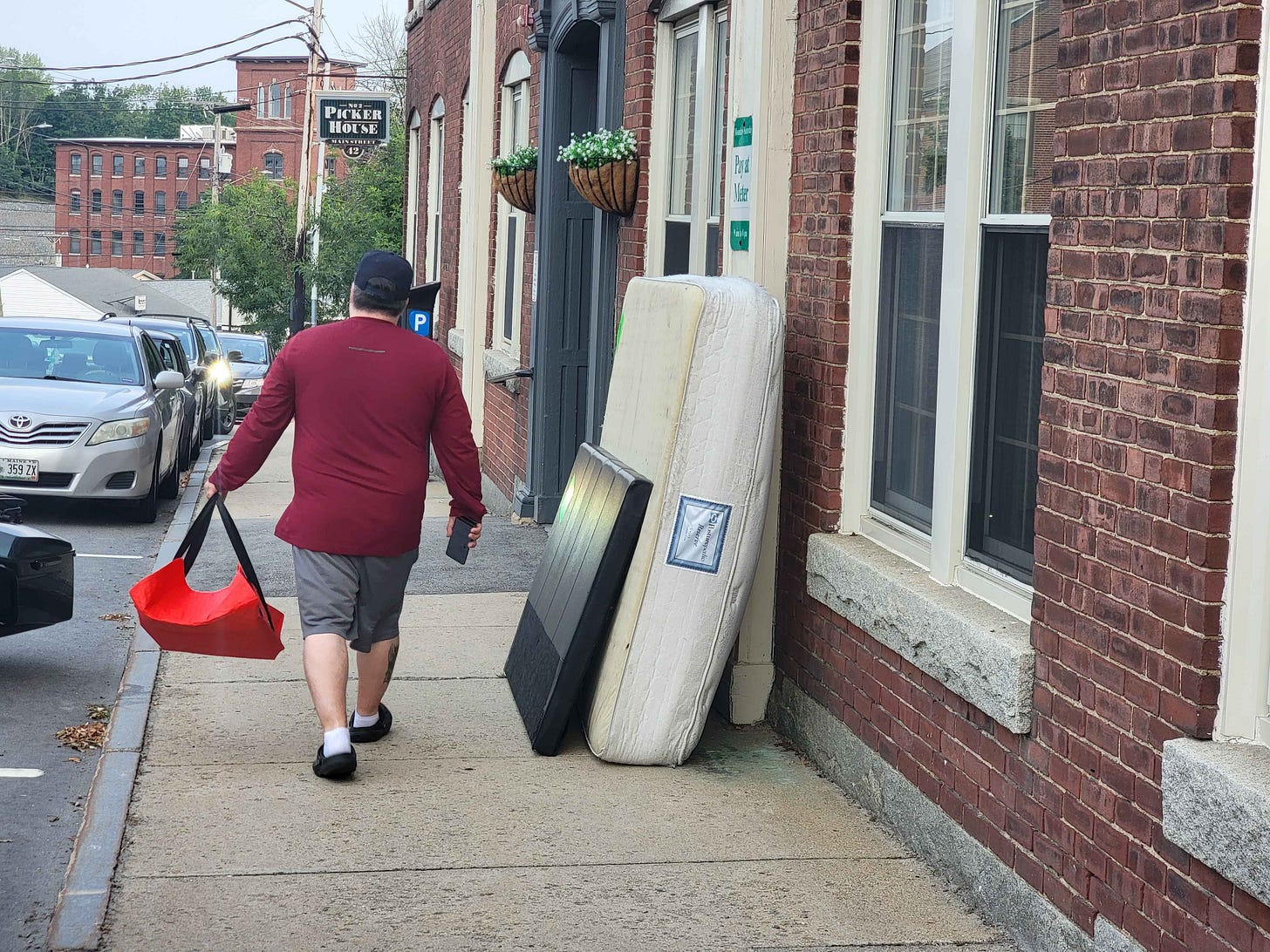
As we made our way up Main Street we passed by some bulky trash that was set out on the sidewalk. From the picture above you can see that the delivery man is taking up most of the available space and the rest is taken up by the trash. Is there a better place for residents in this area to put bulky items? There are several parking spaces in front of the building, could one of those be dedicated to trash collection on pickup days? Instead of blocking our sidewalks we only lose access to a single parking spot once a week and preserve that limited space for walking. Maybe this was a rare scenario and we just happen to walk by at the right time, but seems like an opportunity to give the residents here a better option than to block the sidewalk.
Conclusion
Our walking audit saw and discussed more than we are talking about in this article and it feels good to walk around town with the mindset of what could we change for the better. It invites us reimagine our public spaces and ask ourselves what is possible in our communities. Thank you so much for reading and I hope to see you at a future meeting!

